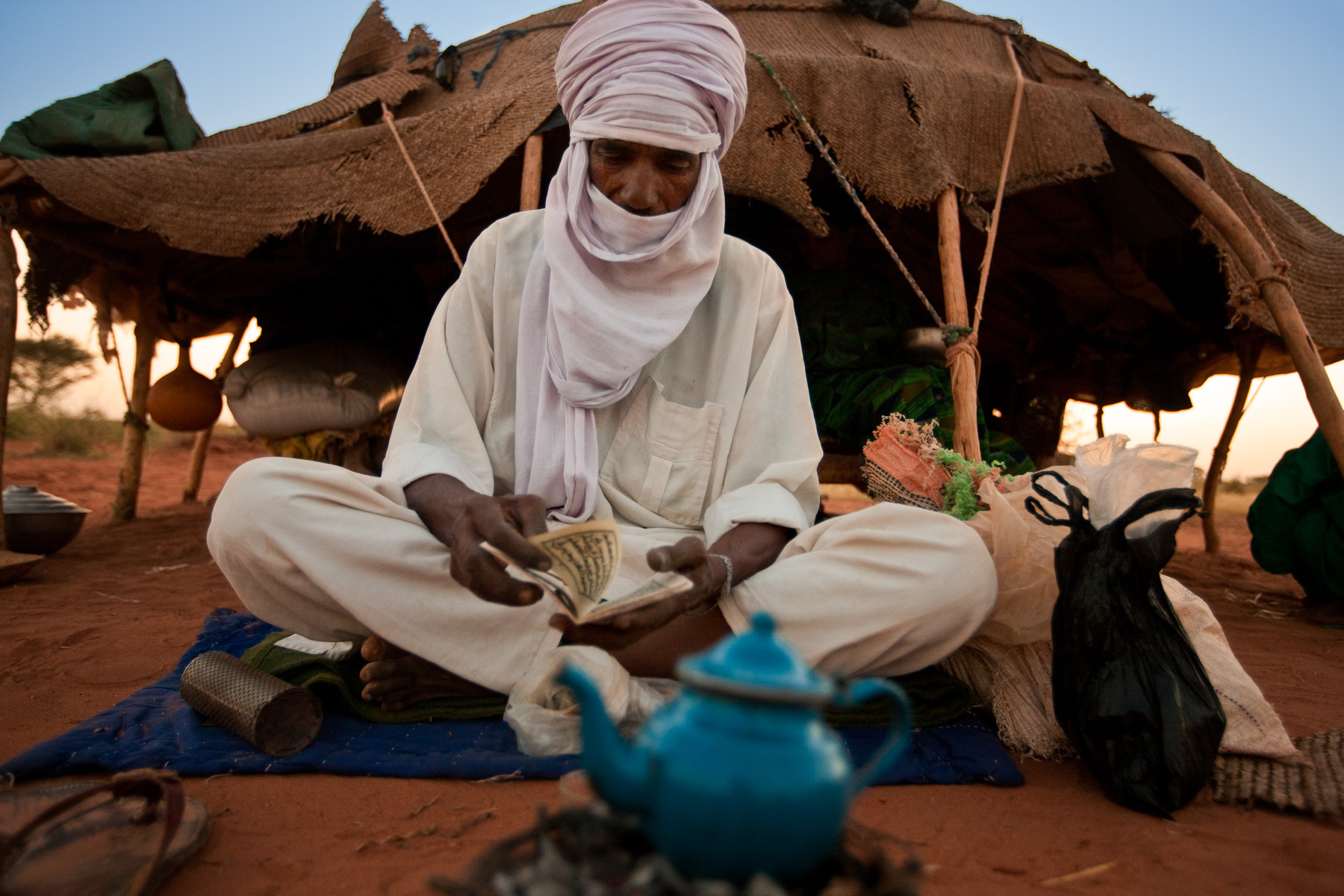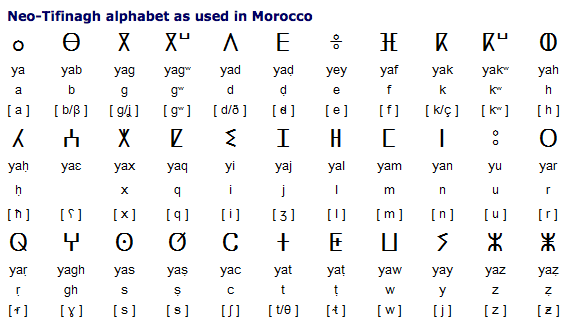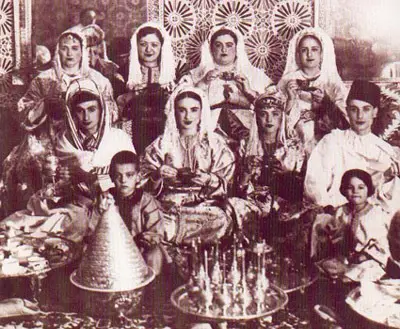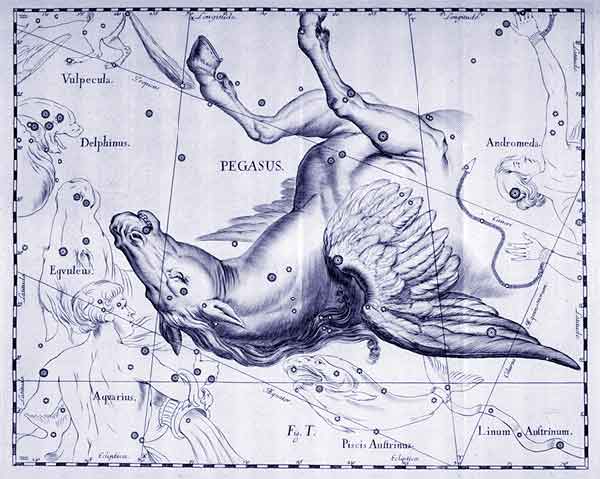- Imazighhen (ⵉⵎⴰⵣⵉⵖⴻⵏ, "free men") they are probably one of the most authentic, long-lived and interesting cases of a nomadic population that has come down to our times. Better known as Berberi (as called al-barbar by the Arabs), are the last nomadic population currently present in the geographical area of the Sahara. Little is known about them except information that comes to us from the chronicles of the empires and kingdoms (then dissolved over the centuries) that have had to do with them for geographical proximity and economic reasons (Egyptians and Romans (in primis)).

History and origins
Accredited theories estimate the appearance of the Berbers around 20.000 BC in the northern part of Africa, probably deriving fromman of Mechta-Afalou (a variant of the paleo-europoid of Cro-Magnon man) which settled in the territories of North Africa until 10.000-5.000 BC when the appearance of the Capsians pushed the Mechtoid-type populations more and more towards the west, leading them to colonize the Canary Islands and abandon the North African settlements.
More certain and unambiguous are certainly the news that came to us from the Egyptians that cited the ṯmḥw, the Rbw and of mswsh already in the pre-dynastic age around 3.000 BC; the latter two will later be known as Libu (or blonde libyans belonging to Peoples of the Sea, confederation of ethnic groups then crushed by the Egyptian pharaohs, in particular Ramesses III the Victorious) and Meshwesh (the people of the Ma) who even became pharaohs around 1.000 BC, being included in the Egyptian kingdom during the expansion to the west.
The continuous contention of North Africa by the great kingdoms led to the collapse of the Egyptian dynasties and the invasion of the Punic and Phoenician peoples who founded their largest cities in the properly Berber territories such as Carthage (814 BC) and Oea (Tripoli di Libya, 700 BC); immediately afterwards the Greeks also arrived who instead of starting conflicts with the endemic peoples built only the flourishing colony of Cyrene (630 BC) in the current district of al-Jabal al-Akhdar in Tunisia. In North Africa there was therefore a precarious balance where different ethnic groups lived in peace after the collapse of the Egyptian empire (which had very violent and englobing connotations) praying to their gods and practicing their main activities (trade, crafts and sheep farming) in territories their own, recognized in turn by other populations.
This balance, however, was broken from the moment that the Punic Wars began because the arrival of the Romans broke the thin thread that allowed all African populations to coexist in serenity; the fall of Carthage and the subsequent annexation of all North Africa to the Roman Empire destroyed all that ecosystem self-governed by the Berbers who saw themselves pushed further and further south, losing many of the sites they founded and undergoing a real diaspora like the Jewish one.
Given the multiculturalism of the Roman Empire, several Berbers united with the European peoples and were incorporated in all respects into the social system of the city, many of them learned Latin and studied in the "lands of the invaders" giving birth to writers (Terenzio, Apuleius or Tertullian), Christian saints (Santa Monica and Zeno of Verona), Doctors of the Church and eminent Christian philosophers (Sant'Agostino in primis), popes and even emperors (Settimo Severo, Emiliano and Macrino). Until the fifth century AD the African territory remained in Roman hands and then collapsed with the relative collapse of the Western Roman Empire, at which point the territory became the mercy of the expeditions of the Vandals of Genseric and of some bankruptcy campaigns of Justinian (534 AD ) to extend the power of the new Eastern Roman Empire which, however, had to quickly renounce African claims due to the arrival of the Arab hordes.

Culture and language
Born as a nomadic and polytheistic people, the Berbers used to move to follow trade routes and to look for more suitable places to practice pastoralism and agriculture. We owe to them the domestication of dromedaries (until then never used) as a means of transport, which made them very welcome in the eyes of both Romans and Arabs. Contrary to what one might think, the Berbers are not genetically dark-skinned (like the rest of the African population of Negroid origin) but there is certain evidence that up to the Bronze Age (about 1300 BC) among the common genetic traits there were depigmentation, albinism and biondism (a character visible in a residual way only more in the Berber populations of the Atlas and among the Guanches of the Canaries) peculiarities that have gradually been lost with the practice of hybridization as a key to pro-historical survival.
Contrary to the epidermal features there is an attribute that the Berbers have absolutely not lost, and it is that of the language. The Berber language is in fact known among speakers as tamazight which is part of the Afro-Asian linguistic stock with strong inflections and influences from ancient Egyptian, Arabic and Hebrew since for centuries these ethnic groups have entered into relationship with each other due to the continuous movements of the Berber populations (vi they are in fact Jewish Berbers like those living on the Atlas).

Although it can be mistakenly thought that the Berbers speak Arabic given the massive conversion to Islam their original and historical language remains to all intents and purposes the official language; it has in fact its own alphabet, its own grammar and its own internal currents (some even estimate that there are thousands), without counting the dialects zanata spoken by the ancient nomadic tribes. The different Berber states therefore have a tamazight just that it differs in inflections and forms from the others, below in a synthetic list: tashelhit (language of Chleuh, southern Morocco), tamazight of central Morocco or together (Central Morocco), tariff (language of the Rif, northern Morocco and Melilla), taqbaylit o kabyle (Kabylia, in northern Algeria), tashawit (Aurès region, east of Kabylia), tumzabt (Mzab region at the gates of the desert), Tamashek o tamahaq (the language of the Tuareg) e tasoussit (Souss region of Morocco).
Currently the Berber language has legal protection recognized by the countries of North Africa through language institutes such as IRCAM (Institut Royal de la Culture Amazighe; in Morocco), HCA (Haut-Conseil à Amazighité; in Algeria), DNAFLA (Direction nationale de l'Alphabétisation fonctionelle et de la linguistique appliquée; in Mali) and even fromBerber Academy of France. In Morocco and Algeria, Berber is also the official language while it is recognized as the national language of Niger and Mali. In fact, Berber literature is not sterile and can count different narrative cycles including: myths, chronicles and stories.

The Berber culture is at times similar to that of the Arab Bedouins of the Persian Gulf although it differs in different practices and above all as regards the culinary tradition: the Berbers make a massive use of mint tea (which is in fact the most consumed drink in North Africa ) and barley flours for the creation of dishes to be eaten all together and of great nourishment such as couscous. They were also the first peoples to discover the energetic and nutritional contribution of dates and honey (cibaria already known by the Romans and Greeks).
As said several times in this writing, the Berber people then divided into many ethnic groups that embraced different faiths and customs such as the Tuareg who are nomadic but mainly Islamic, or the Jewish Berbers who inhabited the Atlas mountains and who in the last century they moved en masse to France, the United States and the modern state of Israel; the last most authentic heirs are thought to be the Guanches living in the Canary Islands but their small number does not allow a certain and univocal classification.

Religion, mythology and rituals
Given the vast mosaic that is Berber culture in its broadest and broadest sense, it becomes difficult to draw universal lines as regards the spiritual and doctrinal dimension of this people. Being the properly indigenous people of North Africa, it has always possessed strong animistic and polytheistic characteristics while remaining anchored to the "desert beliefs" which see a pantheistic connection with the desert considered a real divinity. The home cults of the Berbers are not known because they are transmitted according to oral tradition and from segment to segment but what is certain is the naturalistic nuance of the ancient cults of nomadic peoples.
With the advent of the Islamic Empire most of the Berbers converted to the new religion, in particular the nomadic people of the Tuareg, assuming however the Malachite philosophical school rather than the Wahhabi one that came from the East. Despite this, they are part of the great family of Sunni Islam.
However, there are some curious exceptions, as mentioned above there is a strong component of Berbers of Jewish religion located mainly in the north-west of Africa, to be precise in the Atlas Mountains near southern Morocco. It is not yet clear why those peoples were converted to Judaism given that historically the Jewish people have never trod the Maghreb territory, it is thought that the Berbers of the Atlas settled there after a long time and that they are not endemic to the African mountains rather are exiled from the Sinai area due to the forced colonization of the Egyptian Empire. Currently this "sect" is reduced to a very small number since most of the Jews then moved to Europe, America and Israel.
The mythology is therefore divided into the various beliefs perpetuated by the Berber people, namely: Islamist, Jewish and animist. As for the first two, there are few differences from the corpus official and universal shared by the various faithful but as regards the last one we need to spend a few words: although it is still complicated to have authoritative and univocal sources, what is certain is that the first Berber population had a cult linked to the seasons and to the natural components that characterized most of the naturalistic cults of that time; certainly there was a strong link with the stars, constellations and the cosmos, useful tools for both worship and divination or simply for orientation during the crossings of the Sahara. A striking example is certainly the Tuareg, of which we have a rather exhaustive and clear explanation of their constellations to which they associated animal and human connotations linking them with millenary myths handed down among the desert steppes.
Below is a synthetic list of the cosmic organization of the Tuareg: Ursa major ("La Cammella" [talamt], which includes 9 other stars), Ursa minor ("The baby of Camel" [äwära/Alegod], which includes the "Polar Star" [Lenkeshem/Lekeshan], the Pleiades ("The Daughters of the Night" [Shet Ehod] mythologically wives of Orion and Aldebaran, they are properly 7 and organized in pairs except for one which is alone: But teseksek - Essek-awet, Ma teleghlegh - Ellegh-awet, Ma teregreg - Erreg-awet e Tit-ennit aba-tet ["She who lacks an eye"], The tail of Aries ("where the Daughters of the Night pray" [tamezgida n Shet Ehod]), Ladi ("The Goats" [ulli], is a luminous cluster that makes up the head of the constellation of Taurus), Corona Boreale ("The blacksmith's hut" [Abuk n enaden], of which Alphecca it is the brightest star, in fact it represents the hearth where these stellar craftsmen work); Orion ("The Guide" [Amanar], composed by Betelgeuse [Afus wa n äghil; "The right hand"], Bellatrix [Afus wa n teshalge; "The left hand"], the Balteo of Orion [Tagbest n amänär; “Amänär's belt” e Takuba n Amanar; "The sword of Amänär "], Rigel [Ader n alaku; “The [left] foot standing in the mud”]; Shield of Orion [tamezgida n Amänär; "The place of prayer of Amänär"], Orion Nebula [Ey (o ashiwa) n Amanar; "The sex of Amänär"]), Taurus [Kukayod], Gemini / Centaur ("The Black Gazelles" ["Ineran"], Southern Cross ["Igarren”, Which represents the plant of Maerua crassifolia endemic to the desert areas of North Africa which in the Tuareg language takes the name of does he have/agar], Lira ("The perched vulture" [égädär wa sgänän], with its brightest star Vega), Eagle ("The vulture in flight" [égädär wa iggädän], with its brightest star Altair], Swan ("The crowned crane" [Tanegit], Cane Maggiore ("Those who move making sharp noises" [Ifäräkfärakän], Hare ("The dorcas gazelles" [Ihenkad/Izekad], Nave Argo (composed of canopus [Ghusshät; "August"], δ Velorum [Tanaflit; "Well-being"] e Tezzurt; "The malaise"), Cassiopeia ("The young men / the assembly" [Ibaradan/Jamaghat]), Pegasus Square ("The roof" [Tafella], Milky Way ("The way that leads to Aïr" [Tarrayt n Ayer]) and Scorpio [Tezardemt] (composed by: Antares [Abelkoray/Amroth; "A young man climbing it"], scratches e Dschubba [Tibaradin; "The girls"], Tenilt [“The female ostrich”] which represents the tail of the scorpion in turn composed of Saula e Lesath [Tyettawén en tanilt; "The eyes of the ostrich"].

As we can see the Tuareg cosmology has to do with daily analogies such as characterizing the constellations with camels and not with bears as they did in Europe, moreover there are several analogies with Roman and Greek culture (Sirius, Pleiades, Argo, Pegaso, etc.) but mainly there are references to the everyday life of the people as shown by the constellation of the Southern Cross which has as its reference a plant that grew only in the places inhabited and trodden by the "blue skinned peopleOr one of the two names of the Milky Way makes an explicit reference to Mount Aïr, in Niger around which several Berber and Tuareg settlements have flourished. As we can well note the most important constellation is not the one that includes the Polar Star but Orion, which is the reference constellation of the legendary warrior Amänär punished by the gods for having attacked Mother Earth and condemned to be dismembered for the Cosmos to the everyone's view (strong references to the "Fall from Heaven"Of Lucifer).
As for the rituals of the Berbers, however, there is no certain information as for the Tuareg cosmology, what we do know is that in addition to being a traditional society they are not too affected by the patriarchal and monogamous heritage; indeed, in the Tuareg caravans it is possible that it is precisely a woman the member with more authority and experience but these are specific cases that cannot be valid for a universal generalization.
Regarding the funeral ritual, however, one thing is certain: in the North African context it was not the Egyptians who first mummified the bodies of the dead but the Guanches, who knew this funeral practice long before people of the pyramids and this is demonstrated by the discovery of a mummy in Libya in 1958 which predates any Egyptian mummy found so far. Unlike the Guanches, the Berbers used to sprinkle the body of the deceased with red ocher and place it in a fetal or lateral position, however this custom was introduced by the Capsian peoples who inserted inside the tomb: oyster shells, jewels and weapons (custom later taken up by the Egyptians and shared with many other peoples) [cf. Enigmas of the Mediterranean: the Guanches, the 'Peoples of the Sea' and Atlantis].
Bibliography:
- Hugh Fabietti, Cultures in the balance. Anthropology of the Middle East (Bruno Mondadori, 2002).

Very interesting, thanks for these
information
My girlfriend is Berber!